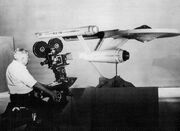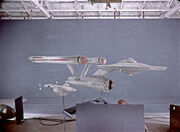Template:Realworld
Film Effects of Hollywood, or FILM EFFECTS of Hollywood, Inc. as its proper denomination read, was a visual effects (VFX) company (in the 1960s still referred to as special effects), founded and operated by Linwood G. Dunn, which has provided visual effects work for the first two seasons of the original Star Trek production, Star Trek: The Original Series.
When the production of the regular series was green-lighted in 1966, after the approval of the second Star Trek pilot "Where No Man Has Gone Before", Associate Producer Robert Justman and Post-production Supervisor Edward K. Milkis, soon became aware of the fact that production of the VFX, required on a week-by-week basis, for the series, the most effects-laden television show to date, went far beyond the capacities of the company hitherto responsible for the effects, the Howard Anderson Company. In order to alleviate the work pressure on Anderson, and to keep production on track, they contracted virtually every other independent VFX house in existence at the time to also work on the show; the Westheimer Company, Van der Veer Photo Effects, Cinema Research and Film Effects of Hollywood. (Inside Star Trek: The Real Story, p. 262) Dunn recalled the specifics of the contract with Desilu, "We negotiated two flat weekly fees, one for use of equipment and another for supervision. Desilu would also cover the actual cost effects production expenses such as salaries of labor personnel, and anything else actually required to get the effects shots done. I chose the personnel and Desilu paid their salaries. That way, if there were script changes or changes in design or execution of shots, that was okay because Desilu was covering all costs on a weekly basis as we went along. They could have flexibility in making changes and we didn't have to worry about about the changes making the work profitable. The only problem was that they were always late getting the sequence to us to work with, so we usually went into overtime to get the shots done in time for airing and they had to cover the overtime costs." (Cinefantastique, Vol 27 #11, p. 71)

Dunn filming the large Enterprise model at his company

DY-100-class and Enterprise studio models on-stage at Film Effects of Hollywood
Though Film Effects worked on a wider range of visual effects for the show, including a multitude of psychedelic light effects, often seen by the USS Enterprise's crew on the viewscreen, the most signature effects they provided were the exterior shots of the starship studio models, especially those of the Enterprise models. The company, located on North Highland Avenue, Hollywood, was more spacious and better suited to handle, in particular, the large eleven-foot model, than Anderson was. It was exactly the production of footage of the latter which was the reason why Film Effects was brought in as the second additional effects company to work on the series, starting with the eighth episode "Balance of Terror", the first episode that required extensive new footage of the eleven-foot model. Until then the series had made do with the footage already shot by Anderson, supplemented by a small amount of additional footage of the small three-foot model. Anderson, already backlogged on the visuals production for "The Corbomite Maneuver", which was still in post-production when production of "Balance of Terror" started, desperately needed the help. (These Are the Voyages: TOS Season One, 1st. ed. , p. 205) Virtually all exterior starship footage, especially those of the large Enterprise model seen in seasons one, after "The Corbomite Maneuver", and season two, were shot at Film Effects, stock footage of which used extensively in the third season. Notable exceptions were, the footage shot of the three-foot Enterprise model for "Tomorrow is Yesterday", and the footage shot of the Deep Space Station K-7 model for "The Trouble with Tribbles", which were done at Anderson's, not Film Effects. During this time Director of Photography Jerry Finnerman closely cooperated with Film Effects, serving as the primary liaison between the company and Desilu. Due to budget cuts, the company, hired on a week-by-week basis, was largely released from providing effects for the third season, the few new starship exterior shots (such as with the new Klingon D7 class model), again done at Anderson's
Film Effects of Hollywood's work on Star Trek was nominated for an Emmy Award once, when Linwood G. Dunn was nominated in 1967 for Individual Achievements in Cinematography, together with Darrell Anderson and Joseph Westheimer.
None of Film Effect's production staff, including Dunn himself for that matter, were ever individually credited for their contributions to The Original Series, instead being officially credited collectively under the company name.
Work outside Star Trek
Linwood Dunn, a pioneering innovator in the field of VFX, founded his company in 1946, as he found his talents in increasing demand, not only by RKO Pictures, the company he usually worked for, but by other production companies as well, and he operated his company besides his work for RKO. His company specialized in VFX and optical printing services, including adapting foreign film standards to U.S. standards and the handling of large format films, but served as a research house as well, for the development of cinematographic equipment and techniques, including that of the optical printer, a VFX device, Dunn had developed into a practical piece of cinematographic equipment. RKO Pictures went out of business in 1957 (formally ending its existence in 1959) and from then on Dunn exclusively operated his company, which was strengthened as Dunn managed to firstly lease RKO's special effects department, before definitely acquiring its assets when formal bankruptcy was declared two years later. Productions the company has provided VFX work for in the first two decades of its existence, included the movies "Topper" (1953), On the Beach (1959), Inherit the Wind (1960), the acclaimed West Side Story (1961), The Searching Eye and Kiss Me, Stupid (both 1964), In Harm's Way, The Great Race and Ship of Fools (all three 1965), the 1966 movies The Russians Are Coming the Russians Are Coming, The Bible: In the Beginning..., Hawaii, as well as the entire run of the television series The Forest Rangers (1963-1965)
After Star Trek the company continued to provide VFX services to Hollywood productions, such as Airport and Catch-22 (both 1970), The Devil's Rain and "Wonder Woman" (both 1975), Sgt. Pepper's Lonely Hearts Club Band (1978), the science fiction movie The Shape of Things to Come (1979) as well as the 1978 science fiction television series "Project U.F.O.". The movie Alligator (1980) was Film Effects of Hollywood's last recorded credit.
In 1985 Film Effects of Hollywood ended its existence when Linwood Dunn sold off his VFX company to Francis Ford Coppola in order to retire from active effects work. Coppola dismantled the company and utilized the production assets to revitalize his own production company, American Zoetrope. Film Effect's old location was until recently the seat of Fuji Film Motion Picture.
Staff
Staffers involved at the time with the production of Star Trek were among others,
- Linwood G. Dunn - CEO, Visual Effects Producer
- Albert Whitlock - Matte Painter, subcontractor
- Don Weed - Supervisor
Further reading
- "Out-of-this-world Special Effects for 'Star Trek'", Rae Moore, American Cinematographer, October 1967, pp. 715-717
- "Where No Show Had Gone Before", Jan Alan Henderson, American Cinematographer, January 1992, pp. 34-40
- "Special Visual Effects", Daniel Fiebiger, Cinefantastique, Vol 27 #11, 1996, pp. 64-75
External links
- Template:IMDb-link

